Every day, in a rare feat of organisational efficiency and management, 259 Agastya teacher-instructors disseminate hands-on science education to over 4,800 government school children in ten states through its science centre in Kuppam, 28 satellite science centres and 61 mobile science vans, sparking a belated science education revolution in rural India. Summiya Yasmeen reports
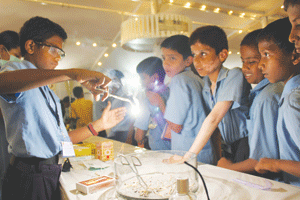 Santosh Banakar, Bhargavi Lokeshwari, Jyothsana Thirupati, Pramod Patil and Anuradha Gangadaharmath — all students of government schools struggling in impoverished rural hamlets of the southern states of Karnataka and Andhra Pradesh — achieved the impossible at Intel’s IRIS (Initiative in Research and Innovations in Science) 2011 national science fair, held in Chandigarh last November. All five students, first generation learners whose unskilled farm labour parents never attended school, won special merit awards at IRIS, a pan-India annual science competition for primary-secondary school students organised by IT multinational Intel in partnership with the Union government’s department of science and technology and Confederation of Indian Industry (CII).
Santosh Banakar, Bhargavi Lokeshwari, Jyothsana Thirupati, Pramod Patil and Anuradha Gangadaharmath — all students of government schools struggling in impoverished rural hamlets of the southern states of Karnataka and Andhra Pradesh — achieved the impossible at Intel’s IRIS (Initiative in Research and Innovations in Science) 2011 national science fair, held in Chandigarh last November. All five students, first generation learners whose unskilled farm labour parents never attended school, won special merit awards at IRIS, a pan-India annual science competition for primary-secondary school students organised by IT multinational Intel in partnership with the Union government’s department of science and technology and Confederation of Indian Industry (CII).
The students’ well-researched proj-ects presented to a jury comprising eminent scientists Dr. Harish Bhat (IISc), Prof. R. Srinivasan (IIT-Guwahati) and Dr. R.K. Paul (St. Xavier’s College, Kolkata), detailing the multi-purpose uses of animal waste and benefits of citrus peel oil as organic pesticide, were adjudged the best of 1,000 entries from 58 schools countrywide. Moreover Bhargavi and Jyothsana’s project ‘Growing oxygen on the highways’ was singled for a special award, winning them a fully-paid trip to participate in the apex-level Intel International Science and Engineering Fair scheduled to be held in Pittsburgh, USA this summer (May).
The miraculous transformation of these students of village government schools — which it’s well-documented, lack basic infrastructure, suffer chronic teacher truancy, multi-grade classrooms and abysmal learning outcomes — into winners of the highly competitive IRIS is the handiwork of the Agastya International Foundation (Agastya, estb. 1999), a Bangalore-based NGO which has constructed a unique, state-of-the-art science education centre for rural children on a 172-acre campus in Gudivanka village, Kuppam Mandal, Andhra Pradesh.
Over the past 13 years since it was promoted by a group of educationists and scientists led by Ramji Raghavan (a former investment banker), Agastya (budget: Rs.12 crore in 2010-11) has reached 5 million children and 150,000 teachers (mainly from rural government schools) in ten states countrywide. Every day, in a rare feat of organisational efficiency and management, 259 Agastya teacher-instructors disseminate hands-on science education to over 4,800 children from government schools in ten states through its major science centre in Kuppam, 28 satellite science centres, 61 mobile science vans, and science fairs. In the process, Agastya has engineered a scalable model for sparking a belated science education revolution in rural India.
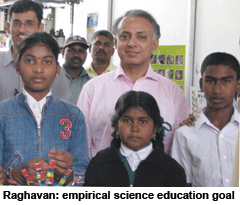 “The objective of Agastya is to arouse the latent curiosity of econo-mically disadvantaged rural children through hands-on science education. We want to enable them to become tinkerers, solution-seekers and problem-solvers anchored in and connected with their rural societies. This is best done by enabling them to access hands-on, experiential science laboratories to learn cause-effect thinking. It’s very satis-fying that since we hesitantly began 13 years ago, Agastya has been successful in making experiential science education available to over 4.5 million rural school children in 25 districts of Karnataka and Andhra Pradesh — and to another 500,000 in eight other states — through our scalable and replicable hub-and-spokes model. Our main science centre in Kuppam — ‘the Creativity Lab’ — is our hub and the spokes are our 28 mini-science centres, 61 mobile science vans supplemented with over 50 science fairs which we conduct annually. This is the largest private science education programme targeted at government school children in India and perhaps worldwide, with special emphasis on delivering contemporary science education to children in the rural hinterland,” says Ramji Raghavan, founder-chairman of Agastya.
“The objective of Agastya is to arouse the latent curiosity of econo-mically disadvantaged rural children through hands-on science education. We want to enable them to become tinkerers, solution-seekers and problem-solvers anchored in and connected with their rural societies. This is best done by enabling them to access hands-on, experiential science laboratories to learn cause-effect thinking. It’s very satis-fying that since we hesitantly began 13 years ago, Agastya has been successful in making experiential science education available to over 4.5 million rural school children in 25 districts of Karnataka and Andhra Pradesh — and to another 500,000 in eight other states — through our scalable and replicable hub-and-spokes model. Our main science centre in Kuppam — ‘the Creativity Lab’ — is our hub and the spokes are our 28 mini-science centres, 61 mobile science vans supplemented with over 50 science fairs which we conduct annually. This is the largest private science education programme targeted at government school children in India and perhaps worldwide, with special emphasis on delivering contemporary science education to children in the rural hinterland,” says Ramji Raghavan, founder-chairman of Agastya.
An alumnus of the Rishi Valley School, Chittoor (Andhra Pradesh), Delhi University and London Business School, Raghavan gave up a 20-year, London-based career in banking and finance (Citibank and Cedel) and returned to India in 2002 to promote a Rishi Valley-style alternate private school in a rural setting. “But when I bounced my idea off educat-ionists and scientists including my father K.V. Raghavan, a former chairman of Engineers India, I became aware that the huge challenges confronting Indian education required more than one school educating 600-700 children. At the time Dr. P.K. Iyengar, former chairman of the Atomic Energy Commission, advised me that the most pressing need was to instill a scientific temper in rural school children who are starved of it. Therefore I made science and technology education for rural children the focus of the Agastya foundation which co-founder Mahavir Kumar and I registered as a charitable trust in 1999. That’s how the idea of a modern science centre in Kuppam — which would welcome hundreds of children from neighbouring government schools every day for empirical science education — was born,” recalls Raghavan (see interview).
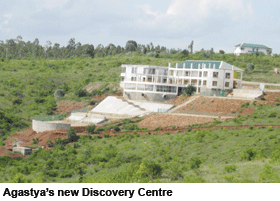 In 2000 with “donations from generous friends”, Agastya purchased 172 acres of barren rocky land in the dusty village of Gudivanka in Kuppam Mandal (pop. 40,000) sited on the border of Andhra Pradesh and Karnataka — a two-hour drive from Bangalore. Construction on the campus didn’t start until the following year when Raghavan managed to raise money from old friend and former Goldman Sachs partner Alok Oberoi who wrote a cheque to fund the Oberoi Centre, housing laboratories for physics, chemistry, and ecology. Since then, the campus has rapidly trans-formed into a Rs.30 crore science facility which includes a 40-room guesthouse powered by a windmill, a workshop where a team of 13 people fabricate low-cost equipment for demonstrating scientific experiments, a large play-ground (6.75 acres) equipped with a football pitch, basketball court and cricket oval, and a Creative Centre for Teaching which houses the math, computer and robotics labs.
In 2000 with “donations from generous friends”, Agastya purchased 172 acres of barren rocky land in the dusty village of Gudivanka in Kuppam Mandal (pop. 40,000) sited on the border of Andhra Pradesh and Karnataka — a two-hour drive from Bangalore. Construction on the campus didn’t start until the following year when Raghavan managed to raise money from old friend and former Goldman Sachs partner Alok Oberoi who wrote a cheque to fund the Oberoi Centre, housing laboratories for physics, chemistry, and ecology. Since then, the campus has rapidly trans-formed into a Rs.30 crore science facility which includes a 40-room guesthouse powered by a windmill, a workshop where a team of 13 people fabricate low-cost equipment for demonstrating scientific experiments, a large play-ground (6.75 acres) equipped with a football pitch, basketball court and cricket oval, and a Creative Centre for Teaching which houses the math, computer and robotics labs.
The latest addition to the campus’ state-of-the-art infra-structure is the 15,000 sq.ft two-storied Discovery Centre — funded by Mumbai-based stockbroker-turned-philanthropist Rakesh Jhunjhunwala, who is a major donor and trustee of Agastya — modeled on the San Francisco Exploratorium and housing jumbo-size interactive models demonstrating a variety of scientific principles and concepts. Adjoining the Discovery Centre are illusion rooms, biology and media labs, and an art centre. Designed by well-known Bangalore-based architect Sharukh Mistry, the scenic Kuppam campus is distinguished by low-rise, environment-friendly stone structures with tiled roofs, which blend seamlessly into the natural environment.
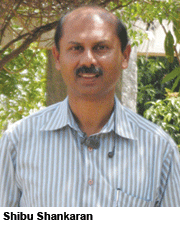 “Agastya’s Kuppam campus is the most well-equipped science education facility in rural India. Altogether our 13 labs offer over 600 science demo models and equipment to students from government schools to experience practical science education. Right now, construction is in full swing to build the first-ever astronomy centre in rural India featuring a planetarium with a suspended 3-D planetary system, and an information technology centre which will comprise a library, computer and art labs,” says Shibu Shankaran, a former veterinary doctor who signed up with the foundation in 2009 and is currently the director of campus facilities.
“Agastya’s Kuppam campus is the most well-equipped science education facility in rural India. Altogether our 13 labs offer over 600 science demo models and equipment to students from government schools to experience practical science education. Right now, construction is in full swing to build the first-ever astronomy centre in rural India featuring a planetarium with a suspended 3-D planetary system, and an information technology centre which will comprise a library, computer and art labs,” says Shibu Shankaran, a former veterinary doctor who signed up with the foundation in 2009 and is currently the director of campus facilities.
As testified by the bulging visitors’ book, among educationists, philant-hropists and the 75,000 people who have visited Agastya’s Kuppam campus, opinion is unanimous that the transformation of the campus from a rocky scrub into a verdant green oasis is an ecological miracle. Under the guidance of faculty of Bangalore University and the Indian Institute of Science led by well-known environ-mentalists Yellappa Reddy and Harish Bhat, an intensive campus afforestation programme was initiated in the year 2000. The outcome is a green campus boasting 600 plant species, a biodiversity park, 12 siddhavanas (medicinal herbs gardens) encircling the statue of Vedic sage Agastya which occupies pride of place at the entrance, a butterfly park, 80 bird species and over 50 species of spiders.
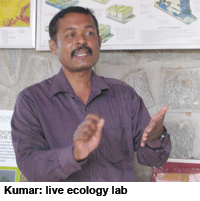 “The Kuppam campus is a live ecology lab for students and teachers to study biology and local flora and fauna. Only organic non-chemical fertilizers and pesticides were used to grow trees and herb gardens. Fifteen check dams have been built to recharge ground water levels, and the campus has 25 percolation points for rainwater harvesting. Moreover, to spread the message of ecology preservation, we distribute 70-120 saplings to villagers every day and have sponsored 80 eco-clubs in government schools in the neigbourhood,” says Laksh Kumar, a postgraduate in earth sciences of Bangalore University who heads the Kuppam campus’ ecology initiative.
“The Kuppam campus is a live ecology lab for students and teachers to study biology and local flora and fauna. Only organic non-chemical fertilizers and pesticides were used to grow trees and herb gardens. Fifteen check dams have been built to recharge ground water levels, and the campus has 25 percolation points for rainwater harvesting. Moreover, to spread the message of ecology preservation, we distribute 70-120 saplings to villagers every day and have sponsored 80 eco-clubs in government schools in the neigbourhood,” says Laksh Kumar, a postgraduate in earth sciences of Bangalore University who heads the Kuppam campus’ ecology initiative.
To study physics, chemistry, biology and ecology experientially every day (six days per week), over 500 classes III-X children and 40 teachers from government schools in neigh-bouring villages and districts are bussed into the campus by Agastya. They spend the entire day (10.30 a.m-3 p.m) on campus studying and experim-enting in small groups of 20, distributed among the labs and other facilities manned by 35 well-trained teacher-instructors. “We keep group sizes small because we want every child to use our lab equipment and conduct live experiments. Our instructors have been trained to deliver practical education and encourage children to discover through questioning, exploration and experimentation. There are over 500 government schools in our neighbourhood and we try and ensure every student gets to spend a minimum of three-four full days on our campus every year,” says Jayamma P.S, a former social worker and head of Agastya’s campus community initiatives which include regular night-time visits to village communities by the foundation’s mobile science vans (“to introduce parents and local communities to simple everyday sciences and personal hygiene, and encourage them to send their children to school”) and 45 community centres in selected villages. The latter offer after-school remedial education to children.
 On the foundation’s sprawling science centre at Kuppam, while children bussed in from neighbouring villages are introduced to new science pedagogies by Agastya instructors, the teachers who accom-pany them are herded into the Creative Centre for Teaching for all-day training sessions conducted by a seven-member team led by P. Manjunath, a micro-biology postgraduate of Periyar University, Salem (Tamil Nadu). “Since we have them only for a day at a time, we do our best to expose them to ways of making science subjects interesting and joyful for children. Since labs or lab equipment are rarities in government schools, we teach teachers to make low or no-cost aids to demonstrate science concepts and ways and means to apply the sciences in their every day lives,” says Manjunath, adding that the centre also provides compulsory 20-24 days in-service teacher training programmes to the 259 Agastya teacher-instructors employed on the Kuppam campus, in the 61 mobile science vans, and 28 satellite science centres.
On the foundation’s sprawling science centre at Kuppam, while children bussed in from neighbouring villages are introduced to new science pedagogies by Agastya instructors, the teachers who accom-pany them are herded into the Creative Centre for Teaching for all-day training sessions conducted by a seven-member team led by P. Manjunath, a micro-biology postgraduate of Periyar University, Salem (Tamil Nadu). “Since we have them only for a day at a time, we do our best to expose them to ways of making science subjects interesting and joyful for children. Since labs or lab equipment are rarities in government schools, we teach teachers to make low or no-cost aids to demonstrate science concepts and ways and means to apply the sciences in their every day lives,” says Manjunath, adding that the centre also provides compulsory 20-24 days in-service teacher training programmes to the 259 Agastya teacher-instructors employed on the Kuppam campus, in the 61 mobile science vans, and 28 satellite science centres.
 According to P. Murali, a class VI-X science teacher of the government-run Zilla Parishad High School in Aremanapenta (AP), the one-day training session at Kuppam is very useful. “Our school doesn’t have a lab and neither is there any in-service teacher training. But on the one day I spent at Kuppam last month, I learned a whole new way of teaching science by demonstration and the art of making low-cost teaching aids out of paper, twigs and straw. Full-day visits to the science centre are stimulating for our students. When they return to school they are full of questions, curiosity, and want to know more about scientific principles,” testifies Murali.
According to P. Murali, a class VI-X science teacher of the government-run Zilla Parishad High School in Aremanapenta (AP), the one-day training session at Kuppam is very useful. “Our school doesn’t have a lab and neither is there any in-service teacher training. But on the one day I spent at Kuppam last month, I learned a whole new way of teaching science by demonstration and the art of making low-cost teaching aids out of paper, twigs and straw. Full-day visits to the science centre are stimulating for our students. When they return to school they are full of questions, curiosity, and want to know more about scientific principles,” testifies Murali.
The serious intent of Ramji Raghavan and the Agastya management to plant the seeds of scientific enquiry in rural India sine qua non, is proven by the foundation’s two-way experiential science learning dissemination model. Not only is the proverbial Muhammad welcome to the mountain, the movement is reciprocal. Even as primary-secondary school students and teachers from villages within a 40-km radius of the centre are bussed to Kuppam, another fleet of 61 fully-fitted mobile vans take Agastya’s ‘science on wheels’ progra-mme to government schools in ten states countrywide. The Agastya management flagged off the foundation’s first mobile science van in 2002 — even as construction of the Kuppam campus began — fitted with lab equipment donated by the Mumbai-based Homi Bhabha Centre for Science Education, to reach government school children in remote rural areas.
Currently the foundation’s 61 mobile science vans — manned by a driver, two well-trained science teachers and fitted with lab equipment and models (including a solar system model), LCD, DVD player and UPS — visit remote rural schools in ten states of the Indian Union. Typically, an Agastya mobile science lab parks for an entire day in a government school with on-board science teachers conducting curriculum-related science experiments to explain physics, chemistry and biology (PCB) theoretical concepts. The teacher-instructors also have a brief to identify “bright and talented students who exhibit curiosity and think laterally”. Selected children are inten-sively mentored and trained under a special Young Instructor Leader (YIL) programme to become student instructors (see box).
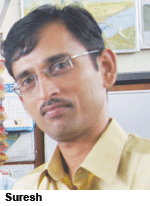 “We ensure that a mobile science van visits all selected government schools at least three times per year. During the first visit, on-board teacher-instructors introduce children to active science learning by conducting 40 lab experi-ments. In the second visit, students are taught to make low-cost science-based display models and on the third visit, a science fair is held at the school with students displaying and explaining the scientific principles behind the models they’ve made to their peers,” says Suresh T.S, head of Agastya’s science on wheels programme in south Karnataka.
“We ensure that a mobile science van visits all selected government schools at least three times per year. During the first visit, on-board teacher-instructors introduce children to active science learning by conducting 40 lab experi-ments. In the second visit, students are taught to make low-cost science-based display models and on the third visit, a science fair is held at the school with students displaying and explaining the scientific principles behind the models they’ve made to their peers,” says Suresh T.S, head of Agastya’s science on wheels programme in south Karnataka.
Of the 61 mobile science vans operational countrywide, 39 ply the lonely rural roads of the southern state of Karnataka (pop. 57 million) following a memorandum of understanding inked between the state government and Agastya in 2005. Under the terms of the MoU, the state government reimburses Agastya the operational expenses of fuelling and maintaining 30 mobile labs — the funds deployed from the state government’s Sarva Shiksha Abhiyan (education for all programme) budget. Commendably, the education ministry of India’s most corrupt state (according to a Transparency International India 2011 survey) has speedily cleared an Agastya proposal to establish science centres in 20 districts of the state. Typically, these mini-science centres are housed in a hall or room of state government buildings/schools and equipped with science models and other lab equipment and are manned by Agastya teacher-instructors. Every day over 100 children from government schools in the district are bussed by Agastya to each of the 28 centres (eight are privately funded).
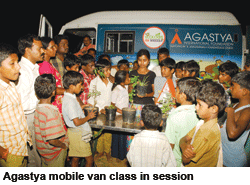 “These science centres serve as a hub for our mobile science van activities in the district. They are also resource centres and teacher training hubs, facilitate students’ project assignments and stage summer science camps,” says Nitin Desai, the Hubli-based head of Agastya’s north Kar-nataka operations.
“These science centres serve as a hub for our mobile science van activities in the district. They are also resource centres and teacher training hubs, facilitate students’ project assignments and stage summer science camps,” says Nitin Desai, the Hubli-based head of Agastya’s north Kar-nataka operations.
According to Desai, the Hubli district, which hosts north Karnataka’s largest science centre, was also the venue of Agastya’s first mega science fair conducted in 2008. Since then over nine science fairs have been convened by the foundation in Chennai, Bangalore, Hyderabad, Mumbai and Hubli, where selected government school children mentored by Agastya teachers display and explain science-based model projects to their peers.
A refreshing characteristic of Raghavan and the Agastya management team is that despite the 13-year-old science education promotion found-ation having established an excellent reputation in India and abroad (Raghavan has made presentations at high profile international forums including the Clinton Global Initiative, Harvard India Forum and Education World Forum), they regard Agastya as a work in progress.
Last year the foundation’s research and development cell launched its innovative ‘lab-in-a-box’ programme. Under the programme, ten boxes each comprising elementary aids for explaining 200 PCB science principles are ‘lent’ out to ten government primary-secondary schools. After ten days the lab boxes are exchanged with another school. “In effect every month 600 science principles and concepts are explained and demonstrated to children in each class with the help of elementary aids in each lab-in-a-box. We have successfully piloted this programme in Hubli, and plan to roll it out in other districts of Karnataka followed by Andhra Pradesh. In our opinion, it could revolutionise science teaching-learning in primary schools,” says K. Thiagarajan, a graduate of IIT-Madras and IIM-Ahmedabad with over 35 years corporate experience, who signed up with Agastya in 2009 as chief of operations.
Over the past 13 years when construction work began on its Kuppam campus and its first mobile science van was flagged off, Agastya has grown into one of India’s largest education NGOs with over 400 people including 259 instructors/teachers on its muster roll. Yet an innovative feature of Agastya’s human resource development policy is that all instructors (graduates and/or Plus Two school-leavers) are hired from the local communities because of their “commitment to the welfare of their local communities and knowledge of local language, culture and conditions”.
With similar attention to detail and minutae, great care and effort has been invested in developing experiential PCB curriculums mapped with the syllabuses prescribed by the Karnataka and Andhra state examination boards. A stellar panel of resource people comprising eminent scientists including Prof. S.V.S. Subramanyam and M.A. Ramaswamy (Indian Institute of Science); Dr. V.K. Atre (former head of DRDO); R. Krishnan (DRDO); Prof. S. Parthan (IIT-Kharagpur), M. Shivkumar, former chief designer of HMT, and Prof. D.R. Baluragi, have developed the Agastya science curriculum and demonstration models as well as trained Agastya teachers. “In mainstream schools, there is aversion to science because PCB are textbook-heavy subjects. On the other hand our objective is to instill a love for science subjects in children by giving free play to practice-based learning. Our instructors teach by demonstration and students prove science principles and concepts through experimentation,” says K. Balaram, a graduate of B.R. Ambedkar Open University, Hyderabad, who signed up in 2002 as Agastya’s first mobile lab teacher-instructor, and is currently the foundation’s Kuppam-based head of academics.
 Even if belatedly, the Agastya management’s sustained focus on promoting joyful, experiential sciences education to the neglected children of rural India, is beginning to impact the slow-learning leaders of Indian industry and government. In 2010-11, over six national and international foundations (including R. Jhunjunwala Foundation, Deshpande Foundation and Oberoi Family Foundation) and 18 corporates (Synopsys, IBM, Cairn, L&T, Agilent, HDFC, SBI, Axis Bank, etc) loosened their purse strings to chip in with donations and sponsorships aggregating Rs.5 crore. “We are happy that an increasing number of corporates and institutional donors are supporting Agastya initiatives. But this volume of funds flow barely covers our current annual expenditure of Rs.8 crore. Recently, we have drawn up an ambitious but necessary plan to accumulate a corpus fund, for which we will aggressively target India Inc — which desperately needs well-educated workmen — and retail, i.e individual donors. Moreover, since our focus is on sound science education of government school children, we also want state governments to support us. For instance in Karnataka, the government meets the operational expenses of the mobile science vans plying in the state, as well as of mini-science centres in 20 districts. We’ve also signed an MoU with the Karnataka government under which it will fund a full-fledged science centre modeled on our Kuppam campus in Raichur district and five satellite science centres,” says Mahavir Kumar, former president of the Karnataka Stock Exchange and founder managing trustee of Agastya.
Even if belatedly, the Agastya management’s sustained focus on promoting joyful, experiential sciences education to the neglected children of rural India, is beginning to impact the slow-learning leaders of Indian industry and government. In 2010-11, over six national and international foundations (including R. Jhunjunwala Foundation, Deshpande Foundation and Oberoi Family Foundation) and 18 corporates (Synopsys, IBM, Cairn, L&T, Agilent, HDFC, SBI, Axis Bank, etc) loosened their purse strings to chip in with donations and sponsorships aggregating Rs.5 crore. “We are happy that an increasing number of corporates and institutional donors are supporting Agastya initiatives. But this volume of funds flow barely covers our current annual expenditure of Rs.8 crore. Recently, we have drawn up an ambitious but necessary plan to accumulate a corpus fund, for which we will aggressively target India Inc — which desperately needs well-educated workmen — and retail, i.e individual donors. Moreover, since our focus is on sound science education of government school children, we also want state governments to support us. For instance in Karnataka, the government meets the operational expenses of the mobile science vans plying in the state, as well as of mini-science centres in 20 districts. We’ve also signed an MoU with the Karnataka government under which it will fund a full-fledged science centre modeled on our Kuppam campus in Raichur district and five satellite science centres,” says Mahavir Kumar, former president of the Karnataka Stock Exchange and founder managing trustee of Agastya.
Thirteen years after it was tentatively launched as a sciences promotion initiative for high-potential but neglected children languishing in Andhra and Karnataka’s dysfunctional rural government schools — where PCB subjects are at best taught ritually and minimally — the kinks and flaws of the Agastya science education model have been ironed out. Today, this break-through initiative has blossomed into a robust primary-secondary science education dissemination model ready for replication.
This assertion is confirmed by telecom and tech guru Sam Pitroda, hitherto chairman of the National Knowledge Commission, who in a report Attracting Talented Students to Maths and Science submitted to prime minister Manmohan Singh in May 2008, endorsed Agastya’s sciences education model for implemen-tation countrywide. “A science popularisation programme should be launched to effectively cover children across India. This programme should bring all popular science activities under one umbrella for rapid implemen-tation and replication of successful initiatives. A large chain of science talent cells should be created and each school should be funded to open a science club. The school science clubs can be then networked to the local centres of science. The local science centres should have experimental models to demonstrate basic science concepts. The centres would be equipped with personnel to explain and answer questions of students… Replication of the Agastya International Foundation’s mobile lab programme, with possible public-private partnership mode for implementation, should be considered for various states,” wrote Pitroda.
Ramji Raghavan believes the Agastya sciences education model is ready for nationwide roll out. According to him, it will cost the Central/state governments Rs.15,000-20,000 crore over ten years — a mere 3 percent of the education budget — to replicate the Kuppam model in all 640 districts of the country (see interview p.84).
Meanwhile even as it awaits official support, the Agastya management has worked out a Master 2020 plan under which it will take its unique sciences education model to 50 million children in rural government schools during the next decade when the foundation will double its fleet of mobile science vans to 125, roll out its lab-in-a-box programme, train 1 million teachers and expand the ambit of its operations from ten to 12 states countrywide.
With 5 million government school children in rural Andhra Pradesh and Karnataka learning the mysteries of physics, chemistry, biology and ecology joyously and experientially — living proof of the efficacy of the Kuppam model — quite clearly, India’s overdue grassroots science and technology revolution has begun to gather mom-entum. The several IRIS awards bagged by first-generation learners from schools touched by the Kuppam experiment is a harbinger of things to come.
With Paromita Sengupta (Kuppam & Bangalore)